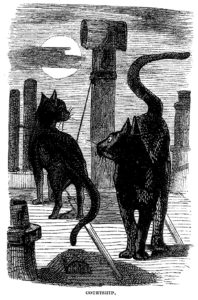The incongruity is the fascination of it all. In New York, the most modern of all large cities, the very embodiment of twentieth-century youth, thrives superstition, gray with countless centuries of age. Where thick-packed multitudes mass, many a charm is said over the sick, many a spell is mystically woven. There are, in this city, beliefs and weird practices which were old when the earliest scribe began to write on rock.
Down on Mott Street, where gleaming lanterns swing from balconies, where joss sticks burn and the smell of incense is in the air, there is unquestioned belief in fiends and devils, in magic and in spells. And far down along the East River, where great bowsprits stretch far over South Street, where there are casks and bales and endless ropes and chains, you may hear, in ancient taverns nodding dreamily toward the water, marvelous tales from them that go down to the sea in ships, for these weather-beaten men retain their belief in ancient sailors’ lore. Ghosts are told of in the crowded region north of Grand Street. Almshouse dwellers, sitting in the sun, watching the surging tide and the glistening water, tell of spirits and banshees and fays.
Recently the will of a German woman, a dweller on Stanton Street, was disputed because, at her death, it had been found that little bags were hidden throughout her clothing, and that in them were incantations to drive witches away. Attention was drawn, two years ago, to a woman on Ridge Street, who had many clients, and whose specialty was the bringing together of married folk who had drifted apart. She charged twenty dollars to each who invoked her aid, and for that sum she exorcised the evil spirit through whose malignancy the separation had come. One must grope far back among the misty shadows to find the origin of beliefs so menacingly sinister.

Curious it is to find, on Essex or Ludlow Street or East Broadway, a belief in Lilith, the legendary first wife of Adam; but among these women who pronounce incantations against her she is not Lilith as we know her in Rossetti, marvelously beautiful and eternally young, snaring the souls of men in the meshes of her enchanted hair, but a malicious personification of evil, forever watching to steal away the newborn child. Sometimes the filching is interrupted in the very act. A Rutgers Street woman, impelled by a sudden fear, hurried back to her child, and found that in another moment there would have been a changeling substitution. The fairy, interrupted by her return, had tucked the infant hastily back, but with its head toward the foot of the crib.
Superstition is seen, luminous in its ineradicability, in a little book of necromancy, which is widely studied in Teutonic tenements. It tells how to make oneself invisible, how to become impervious to shot, how to cure diseases. Magic words and letters play their part in these dogmas of demonology, which dip far down into the glooming depths of human credulity. The blood of a basilisk, a black tick taken from the left ear of a cat, a stone bitten by a mad dog, the right eye of a live serpent—such are some of the charms or medicines. One is taught, too, how to discover a witch and how to banish her. For people who put faith in sorcery and charms, it is easy enough to believe a woman to be a witch, if she be meager and decrepit, stunted and squeak-voiced, and if she look with a malevolent eye on a world which has treated her malevolently.
Science cannot dispel superstition. Black art has not been banished by the electric light. Myths hold their own in spite of the railroad and the telegraph. Faith is desperately pinned to necromancy. When the wind drifts drearily in from the bay, when the storm shouts over the roofs of Poverty Hollow, when the calling wind echoes dismally in the hallways of Sunken Village and Battle Row and creeps disquietingly out of dusky corners, when the mist clings in ghostly folds about ships and houses, the heart of the superstitious man responds as it did when the wind roared through great forests, and the snow fell and the mist gathered and the glimmering moon shone white before the dawn of civilization.
From “Superstitions of a Cosmopolitan City,” which appeared in the January 1905 issue of Harper’s Magazine.






























































































